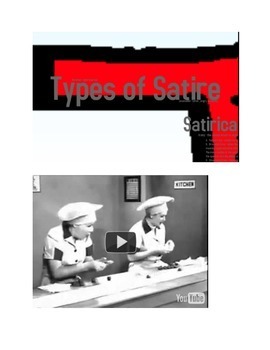Comedic Ladder, Humor Theory, Importance of Being Earnest, Satire Prezi
- PDF
Description
NOTE: The link provided when you purchase should give you access so that you can "MAKE A COPY" to your own account and change it however you wish. My email is included if you have any trouble :)
-----------------------------------------------------------------------------------------------
I use this Prezi to teach my International Baccalaureate and AP Seniors comedy as an introduction to The Importance of Being Earnest. It is a long Prezi--approximately 1 hour and a half, 75 "slides."
This Prezi contains explanations, descriptions, and embedded examples (YouTube clips) of the different rungs of the comedic ladder. It also explores Dr. Richard Tafflinger's Theory of Humor, Elements of Satire, and Notes over The Importance of Being Earnest. (Humor is covered in the ladder, Earnest in the top hat, and Satire in the boy). There are clips from Laurel and Hardy, 3 Stooges, I Love Lucy, Seinfeld, SNL, and Standup.
Areas Covered:
6 elements of comedy
4 rungs of the comedic ladder (low, farce, manners, ideas)--with video clips for each
Background on The Importance of Being Earnest, comedy, well-made play, and themes
Types of satire, satirical devices (including ironies, burlesque, etc), and poetic examples.
Caution!--The stand-up comedy video gets questionable after he discusses Columbus discovering America. I stop the video there.
Please preview all content to make sure it is suitable for your classroom.
-------------------------------------------------------------------------------------------
Prezis are a fabulous way to give a presentation and provide a much-needed break from the traditional PowerPoint. These presentations will have your kids mesmerized (or at least slightly more interested than usual). You can show/view/edit the Prezi online or download it for presentation offline.
The Prezi application is free online. You must have an Internet connection to play YouTube videos, if they are included. If you aren’t familiar with Prezis, go to www.prezi.com and check some out.
When you download the document, there will be a link for your to access the Prezi. You will need to create an EDUCATOR ACCOUNT in Prezi, if you don’t already have one. Don’t worry—It’s free!
When you open the link (with internet connection), then you can select “create a copy” of the Prezi, which will copy the Prezi to your account (make sure you set up your free educator account), so that you can then edit/customize the Prezi. You will also have an option to download should you wish to present it without internet connection.
You have the rights to edit and use your Prezi in your classroom. HOWEVER, please keep your Prezi set at private on your account (under sharing preferences) so that it is not available for anyone else to use.





